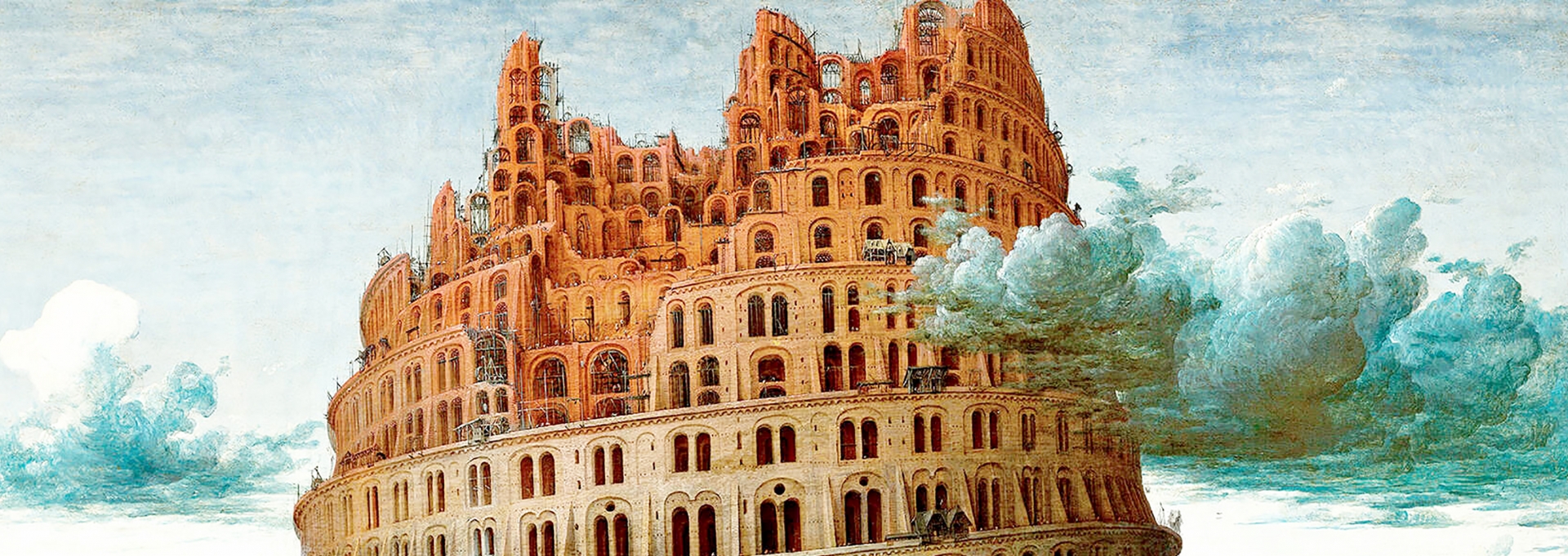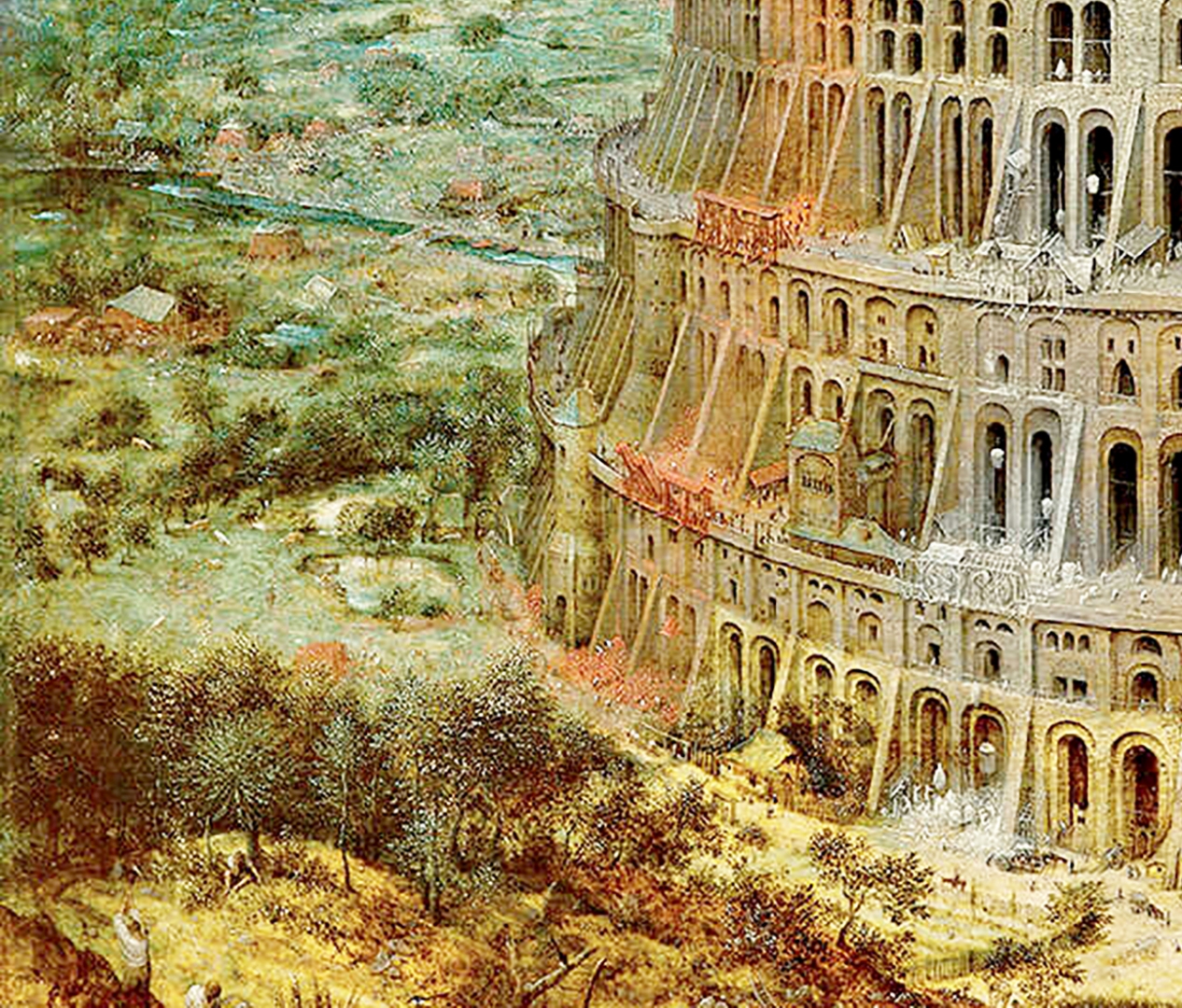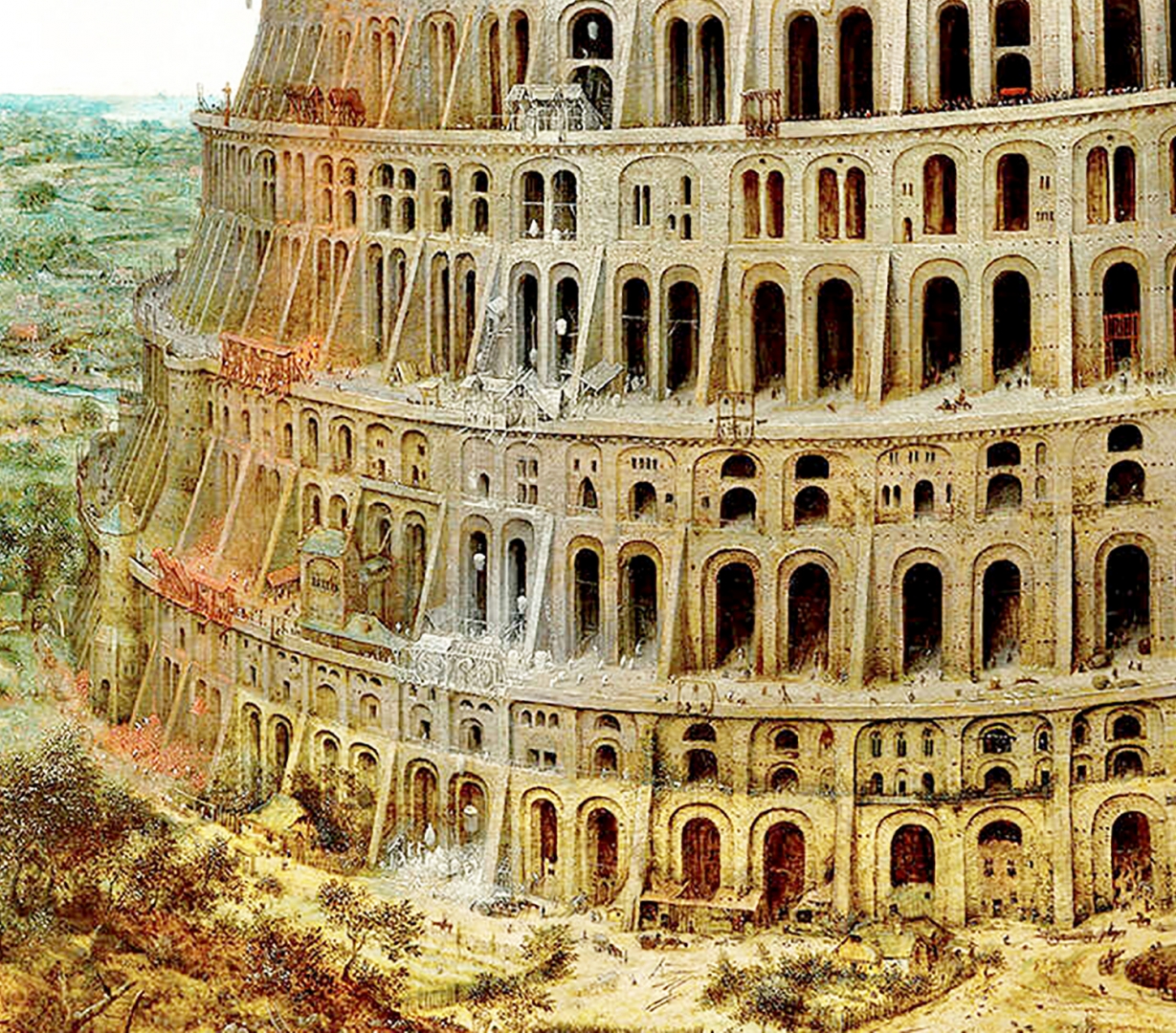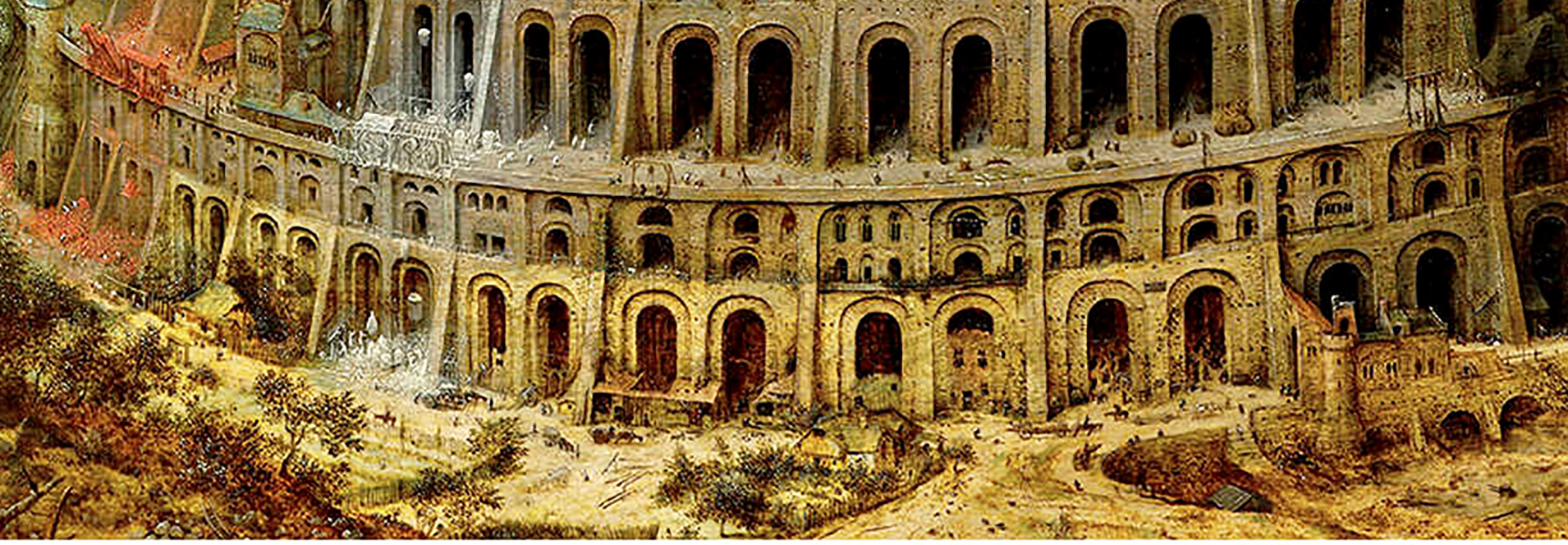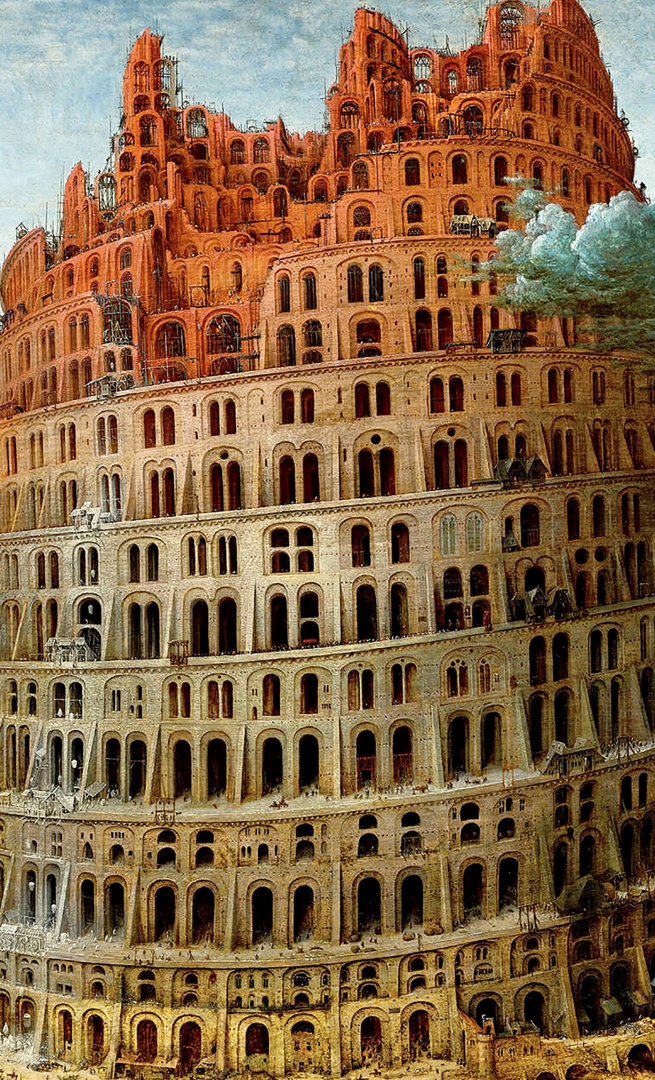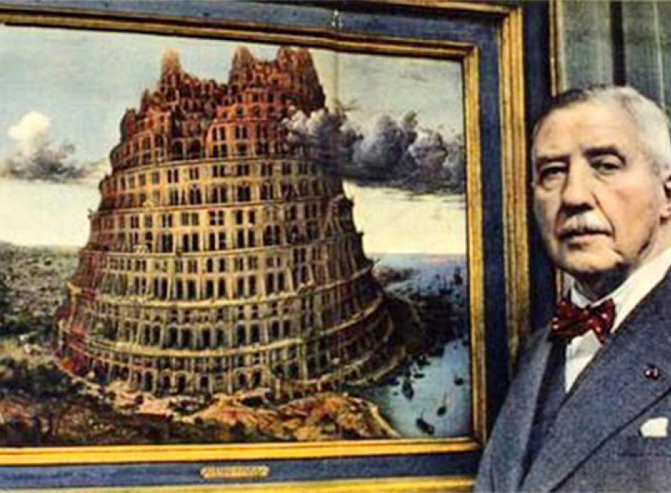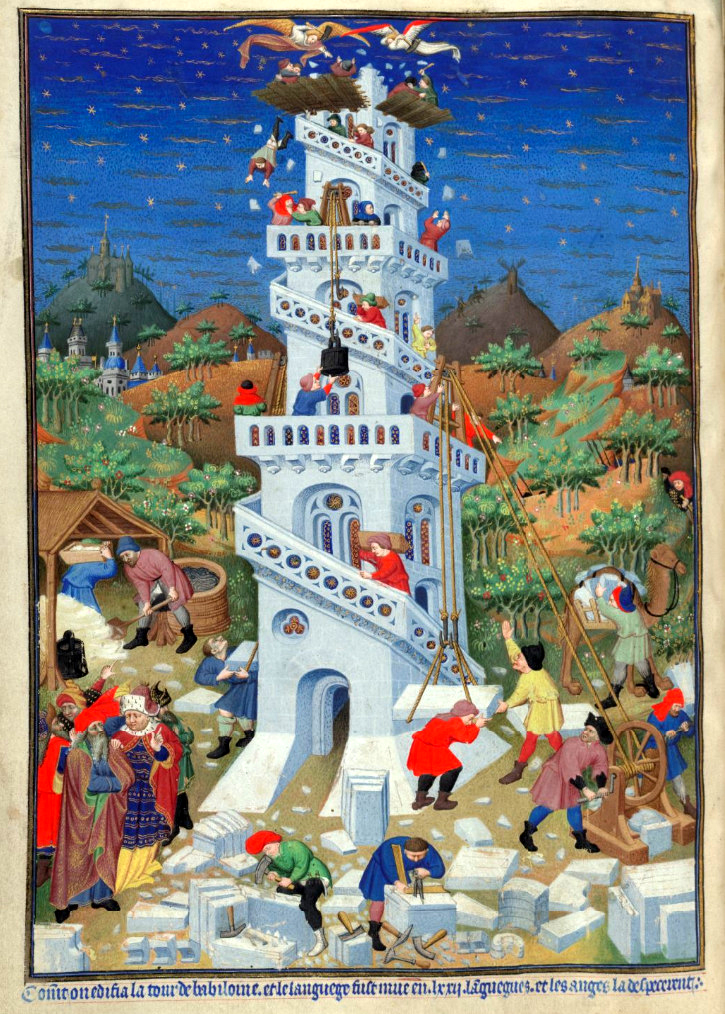At the top, the freshly laid bricks are still red, but at the base of the tower, the stones are already weathered and have taken on the color of the surrounding environment.as a symbol of the madness and arrogant ambitions of humanity. (Genesis 11:1–9)
The story of the Tower of Babel is said to explain the existence of different languages and peoples.
The Bible says that humanity originally spoke one and the same language, but when the Babylonians tried to build a tower that reached into heaven, God disrupted the pretentious project by causing the workers to speak many different languages.
He then scattered them across foreign lands, leaving the tower unfinished.
Pieter Brueghel the Elder created The Tower of Babel around 1560. He was about 35 years old at the time.
In Bruegel’s painting, the tower can be seen rising beyond the clouds, literally reaching up to heaven. On and around the tower, activity swarms everywhere. Countless people are busy constructing the tower.
In the harbor in front of the tower, a large number of sailing ships and galleys are moored.
In the foreground, several figures are chopping down trees and extracting stones from the ground.
The landscape in the background has already been largely deforested. The people living there reside in shabby huts.
In this detailed work, more than a thousand people appear. A magnifying glass is needed to see them.
On the left, at the foot of the tower, men carry sacks of white mortar, which are hoisted upward. A white trail marks the route, just as a red line beside it indicates where the bricks are transported upward.
Everywhere, people are swarming about.
On the third level of the tower, a procession is taking place, and one floor below, riders are on their way upward.
The lower part of the Tower of Babel is inspired by the rounded arches of the Colosseum in Rome.
The work is more than just a depiction of the biblical story.
In the 15th and 16th centuries, the subject was mainly chosen as a symbol of the “wrong world,” human arrogance, and incompetence.
The way Bruegel depicted the tower’s architecture, with numerous arches and other examples of Roman design, is reminiscent of the Colosseum in Rome.
Bruegel surely saw this building during his stay in Rome around 1553.
The Tower of Babel was a popular theme in 16th-century Antwerp.
At that time, Antwerp was a busy port city, with ships arriving from all directions and many different languages spoken on the streets.
This made the Old Testament story about the Babylonian confusion of languages very relevant, and it emphasized that the construction would eventually be halted by the language confusion.
On the painting, however, the work has not reached that point yet—they are still hard at work. The discoloration of the tower shows that construction has been going on for a long time.
At the top, the freshly laid bricks are still red, but at the base of the tower, the stones are already weathered and have taken on the color of the surrounding environment.
It is not known where or when Pieter Brueghel the Elder was born. However, we do know that he lived and worked in Antwerp for most of his life.
In the beginning, he primarily made very precise drawings that served as the basis for producing engravings. It was only later in life that he also took up painting.
He died in 1569 in Brussels. His two very young sons later followed in their father’s footsteps. SYMBOLISM
The story of the Tower of Babel carries a universal message.
The construction of the tower symbolizes humanity’s striving for the highest possible achievements. The biblical structure represents the universal struggle between human ability and vanity, in which God mercilessly punished mankind.
Humans, creative and ambitious as they are, place blind trust in their own abilities and in the limitless possibilities of technology. This pride is punished by God, symbolizing the transience and futility of humanity.
In turn, the artist himself is also somewhat vain in his attempt to paint a tower reaching up to heaven. This further reinforces the message of the story. In Bruegel’s depiction of The Tower of Babel, God’s punishment is clearly not yet taking place: the stones are still being hoisted upward, and the harbor is bustling with activity. Source: Erik Beenker / Boijmans van Beuningen
Symbolism in Western Art
Brueghel the Elder, Pieter – The Tower of Babel
References
Erik Beenker / Boijmans van Beuningen
Symbolism in Western Art
Photo's
wikipedia

Art lijst
Schilderijen
- Bosch, Hieronymus – The Peddler
- Bosch, Hieronymus_The Haywain triptych
- Botticelli, Sandro_Primavera / Spring
- Brueghel the Elder, Pieter – The Tower of Babel
- Campin, Robert — Mérode Triptych
- Courbet, Gustave_Atelier van de schilder
- Dali, Salvadore_Verzoeking van de heilige Antonius
- Dou, Gerard_de Kwakzalver
- Eyck van Barthélemy_Stilleven met boeken
- Fra Angelico_Annunciatie
- Géricault, Théodore_Vlot van Medusa
- Magritte, Rene_Verboden af te beelden
- Matsys, Quinten_De geldwisselaar en zijn vrouw
- Memling, Hans_Twee paarden in een landschap
- Onbekend-16e eeuw_4 gedaantes van een arts
- Picasso, Pablo_Guernica
- Rembrandt_Abraham en de drie engelen
- Rembrandt_Elsje Christiaens
- Velazquez, Diego_Las Meninas
Schilderijen en de dokter
- Agenesia Sacrale (a rare congenital disorder in which the fetal development of the lower spine)
- Alopecia areata (hair loss)
- Arthrogryposis congenita (birth defect, joints contracted)
- Artritis psoriatica (inflammatory disease of the joint)
- Artritis reumatoïde
- Breast development (delayed)
- Bubonic plague
- Difterie (kroep)
- Gigantisme & Acromegalie
- Hazenlip (cheiloschisis) / gespleten gehemelte
- Herpes zoster (gordelroos)
- Hongeroedeem
- Influenza Epidemic of 1858
- Keisnijding
- Krankzinnigheid - Malle Babbe (1640)
- Kropgezwel (struma)
- Lepra
- Liefdesziek, zwangerschap
- Lymfkliergezwel (lymfoom), non-Hodgekin
- Manische Depressie Psychose
- Mazelen? / Rubeola? (acute virale infectie)
- Melanoom of naevus (geboortevlek)
- Membraneuze glomerulonefritis
- Moord (pneumothorax, slagaderlijke bloeding)
- Neurofibromatose
- Oogoperatie
- Osteoartrose / hallux valgus
- Osteomyelitis
- Otitis media (acute middenoorontsteking)
- Parotitis (mumps)
- Platvoet en Spitsvoet
- Polio
- Prepatellaire bursitis
- Progeria
- Pseudohermafroditisme
- Pseudozwangerschap
- Psychoneurose (acute)
- Rachitische borst
- Reumatische koorts (acute)
- Rhinophyma of knobbelneus
- Rhinophyma rosacea_depressie
- Rhinoscleroma
- Schimmelziekte_Favus
- Syfilis (harde 'sjanker')
- Tandcariërs
- Tuberculose long
- Ziekte van Paget
Schilders
Historie lijst
- 1632-1723_Antonie van Leeuwenhoek
- 1749-1823_Edward Jenner
- 1818-1865_Ignaz Semmelweis
- 1822-1895_Louis Pasteur
Wetenswaardigheden lijst
- 1887 Psychiatric Hospital
- Animals on duty
- Bizarre advice for parents
- Bloodletting
- Bloodthirsty Hungarian Countess Elizabeth Báthory (1560–1614)
- Butler escaped punishment three times.
- Dance mania / Saint Vitus Dance
- Doktersadviezen deden meer kwaad dan goed
- Franse Revolutie Lodewijk XVI
- Frontaal syndroom (Phineas Gage)
- Hartziekte (Egyptische prinses)
- IJstijd (kleine)_1300-1850
- Inbakeren
- Ivan IV de Verschrikkelijke (1530-1584)
- Kindermishandeling
- Koketteren met koningin Victoria
- Koningin door huidcrème vergiftigd
- Kraambedpsychose (Margery Kempe)
- Massacre in Beirut
- ME stonden bol van de seks
- Mummie bij de dokter
- Plee, Gemak of Kakstoel
- Prostaatkanker (mummie)
- Sexhandel in Londen
- Syfilis was in de mode
- Testikels opofferen
- Tropische ziekten werden veroveraars fataal
- Vrouwen als beul in WOII
- Wie mooi wil zijn moet pijn lijden
- Zonnekoning woonde in een zwijnenstal

